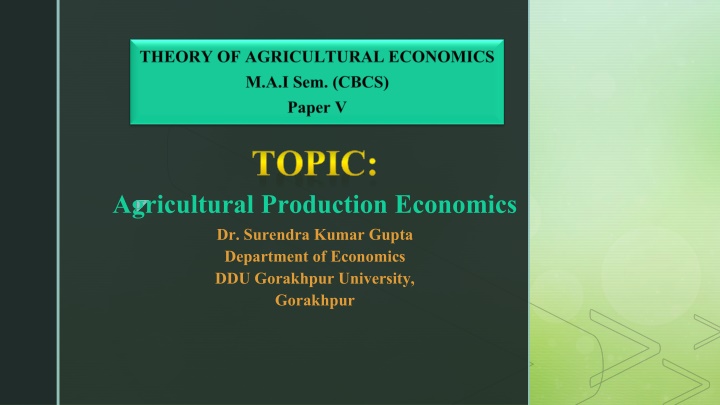
Agricultural Production Economics for Efficient Farm Management
Learn about agricultural production economics, how to maximize profits, make decisions on outputs, allocate resources effectively, and deal with risks and uncertainties in farm management. Explore the goals of farmers, choice of outputs, allocation of resources, and assumptions in production economics.
Download Presentation

Please find below an Image/Link to download the presentation.
The content on the website is provided AS IS for your information and personal use only. It may not be sold, licensed, or shared on other websites without obtaining consent from the author. If you encounter any issues during the download, it is possible that the publisher has removed the file from their server.
You are allowed to download the files provided on this website for personal or commercial use, subject to the condition that they are used lawfully. All files are the property of their respective owners.
The content on the website is provided AS IS for your information and personal use only. It may not be sold, licensed, or shared on other websites without obtaining consent from the author.
E N D
Presentation Transcript
TOPIC: Agricultural Production Economics Dr. Surendra Kumar Gupta Department of Economics DDU Gorakhpur University, Gorakhpur
Agricultural Production Economics ; To maximizing profits, it can be measured by difference between returns from the sale of crops and livestock less the costs of producing these commodities. Individual farmers have unique goals- 1. One farmer might be more interested in obtaining ownership of the largest farm in the province. 2. Another might have as his or her goal that of owning the best set of farm machinery. 3. Another might be interested in minimizing his or her debt load. The goals and objectives of a farm manager are closely knotted with a person's psychological makeup, and the goals selected by a particular person may have very little to do with profit maximization.
Choice of outputs to be produced A Farm manager faces an set of options with regard to what to produce; at given available land, labor, machinery, and equipment. The manager must not only decide how much of each particular commodity to be produced, but also how available resources are to be allocated among alternative uses. The farmer might be interested in maximizing profits but may have other goals as well. Often other constraints enter; For example, The government may permit the farmer to grow only a certain number of acres of a particular commodity. 1. The farmer may have a particular knowledge of, or preference for, a certain commodity. 2. The farm land may be better suited for certain types of crops or livestock than for other types.
Allocation of resources among outputs Once decisions have been made with regard to what commodity or commodities are to be produced, the farmer must decide how his or her available resources are to be allocated among outputs. A simple question to be answered is which field is to be used for the production of each crop, but the questions quickly become far more complex. The amount of farm labor and machinery on each farm is limited. Labor and machinery time must be allocated to each crop and livestock activity, consistent with the farmer's overall objective. The greatest share of this text is devoted to dealing with issues underlying the problems faced by farm managers in the allocation of resources or inputs across alternative outputs or enterprises.
Assumption of risk and uncertainty Models in production economics frequently assume that the manager knows with certainty the applicable production function (for example, the yield that would result for a crop if a particular amount of fertilizer were applied) and the prices both for inputs to be purchased and outputs to be sold. However, in agriculture, the assumption of knowledge with respect to the production function is almost never met. Most farmers would scoff at economic theory that assumes that a production function is known with certainty. Price uncertainty is a result of the biological lag facing the producer of nearly any agricultural commodity, and production in agriculture takes time. Hence farmers must make production decisions with less than perfect knowledge with regard to the price at which the product will sell when it is actually placed on the market.
The competitive economic environment in which the farm firm operates Economists often cite farming as the closest real-world example of the traditional model of pure competition. But the competitive environment under which a farmer operates depends heavily on the particular commodity being produced.
